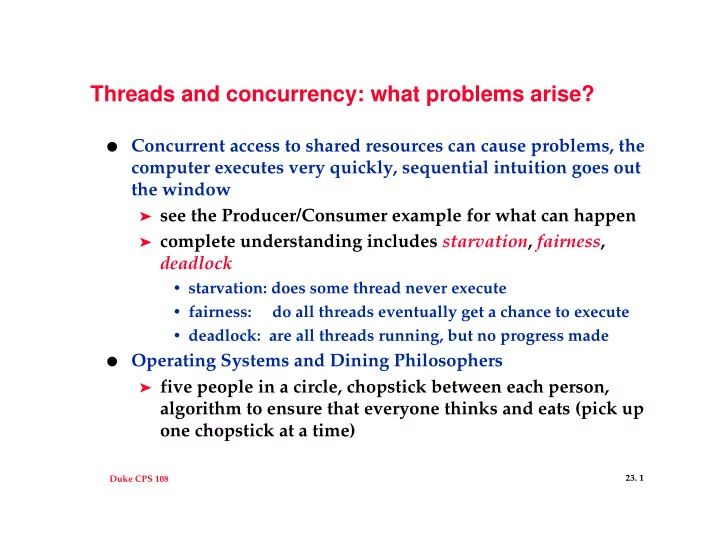

Threads and concurrency: what problems arise? ● Concurrent access to shared resources can cause problems, the computer executes very quickly, sequential intuition goes out the window ➤ see the Producer/Consumer example for what can happen ➤ complete understanding includes starvation , fairness , deadlock • starvation: does some thread never execute • fairness: do all threads eventually get a chance to execute • deadlock: are all threads running, but no progress made ● Operating Systems and Dining Philosophers ➤ five people in a circle, chopstick between each person, algorithm to ensure that everyone thinks and eats (pick up one chopstick at a time) 23. 1 Duke CPS 108
Java threads, Platform problems ● In general avoid tight thread loops that only compute ➤ use Thread.sleep(), use Thread.yield() • yield explicitly gives other threads a chance to execute, but doesn’t pause ● On Solaris machines there’s no guarantee (not required in Java) that threads scheduled with time-slicing, so use yield to ensure some degree of fairness ● Try to avoid dealing with shared resources as in Producer/Consumer problem, hard to get right ➤ Scooter example: what do robots do? • Queue up at destination: factory/robot • Is the destination threaded? Who processes arrivals and departures? 23. 2 Duke CPS 108
Monitors, condition variables ● All objects with at least one synchronized method share a monitor (concept due to C.A.R. Hoare) ➤ access to synchronized methods requires acquiring a lock via the monitor, only one synchronized method is executed at a time on a per-object basis ➤ no process/Thread should hold the lock indefinitely, it’s possible to wait() when the lock is held, relinquishing monitor to other waiting threads, then re-aquire the lock ➤ when a synchronized method finishes, the lock is lost, except for recursive calls --- monitors are re-entrant ➤ see Nutshell and Core v. II, in general when using wait(), use notifyAll() rather than notify() ➤ interfaces can’t be synchronized, see Producer/Consumer 23. 3 Duke CPS 108
Scooter Threads ● If each robot is a thread, what does the thread do? ➤ thread could move robot ➤ thread could draw robot (or both) ➤ advice: let one thread deal with all drawing, ok to have robots update moves in separate threads ● What about a factory? Is it multithreaded? ➤ Two tasks: create boxes, unload boxes. Is this a producer/consumer problem? Are there other possibilities? ● What about a rocket? Is this a problem? ➤ What does a rocket do? ● Can we fix all these problems by having the robots all move/paint in the same thread? 23. 4 Duke CPS 108
Recommend
More recommend